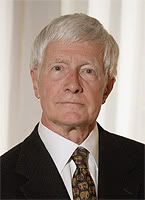Physicist Jim Boyden on Clean Energy
Jim Boyden earned his Ph.D. in physics from Cal Tech the same year I graduated from kindergarten (1960). I joked with him during our interview this morning: “So, while I was trying to master the alphabet, you had risen to a somewhat loftier academic level — and the subject of your dissertation was…. ?”
“High energy particle physics,” he smiled modestly.
I wanted to interview Jim as a part of my third book, “Renewable Energy, Following the Money,” because, since he left academia, he’s been one of the most successful business people that the world of technology has even known. In particular, during his tenure at Hewlett-Packard, Jim started a business for the computing giant in the arena of printing – first laser, then ink-jet: now a mere $20 billion in annual revenues.
Since departing H-P, he’s been performing numerous functions for Microsoft co-founder Paul Allen, helping direct part of Mr. Allen’s vast fortune onto avenues that have potential to “move the needle” in a positive direction for humanity. Needless to say, philanthropists whose net worths are measured in tens of billions of dollars choose their advisors carefully; the stakes are huge, and the levels of professionalism and acuity of insight intense.
A few data points from my talk with Jim this morning:
1) As a culture, we need to develop all clean energy technologies that have the potential to make meaningful contributions, including nuclear. Yes, there are issues with nuclear: safety, waste disposal, and the potential for misappropriation by those wishing to build weapons. But the way nuclear reactors can be made today is far safer than the “stupid” designs that resulted in the accidents at Fukushima and Chernobyl. We wouldn’t replicate those designs today any more than we would put Model T Fords on our highways. And there are huge dangers associated with the coming oil shortages (acute geopolitical tensions — read “wars”), and pumping the aromatics of coal into our atmosphere (lung disease, global warming), the severity of which we tend to under-count when we contemplate the specter of a nuclear disaster. In the absence of a solution, we face a world shortfall of 4 or 5 terawatts (approximately the entirety of the U.S. energy consumption today) in the coming decade or two.
2) There are those who believe (and I happen to be one) that we have all the technology we need right now to solve the energy problems we face; we simply need the political willpower to implement it.
3) Government needs to help. Most investors whose capabilities and interests exceed those of hobbyists want highly likely short-term return on their money — and this is extremely UNlikely in energy. Where software can be developed in months very inexpensively, the opposite is the case in energy, where the investments are often measured in hundreds of millions of dollars, and the return, if there is one, measured in decades.
4) Our elected leaders are not likely to be of much service here. Who runs on the platform that they’re spending taxpayer money on the unknown? And how many people get elected unaffected by the pressure of Big Energy, the largest industry on Earth, with the most powerful lobby in the known universe?
“Where’s there a good benign dictator when you need one?” Jim quips. What a good guy. I’m certainly proud to know him.


I’m surprised he believes in nuclear. As a Physicist is is not looking at where the uranium comes from since 90% is imported to the USA for it’s 104 plants. Sure ,technically we can do it but add up ALL the costs and dangers first.
Renewables can do it all. Solar, Wind Geo-thermal along with existing hydro.
Since the author has a view to the bigger picture, consider that over time there may well be need for fuel for extended space travel, which a small group of NASA scientists and astronauts have postulated and ventured initial design papers for. These designs maintain the idea of the use of nuclear fuel to propel the type of extended travel necessary to visit other inhabitable planets to extend our existance. Wouldn’t it be wise to save our finite supply of nuclear fuel for this future purpose? Specially since our present day needs can be more safely and economically met with distributed energy.
The author seems, like so many other vested interest promoters, to favor those types of energy that are centralized and comercially exploitable. The entire system of centralized energy comoditizes the consumer to the position of “payer” as primary purpose. Distributed energy shares responsibility and profit with a vast network of providers and their attending inovation if the proper incentives for “energy production” are in place. Many in industry are begining to realize this with increased investment in battery development and production technology.